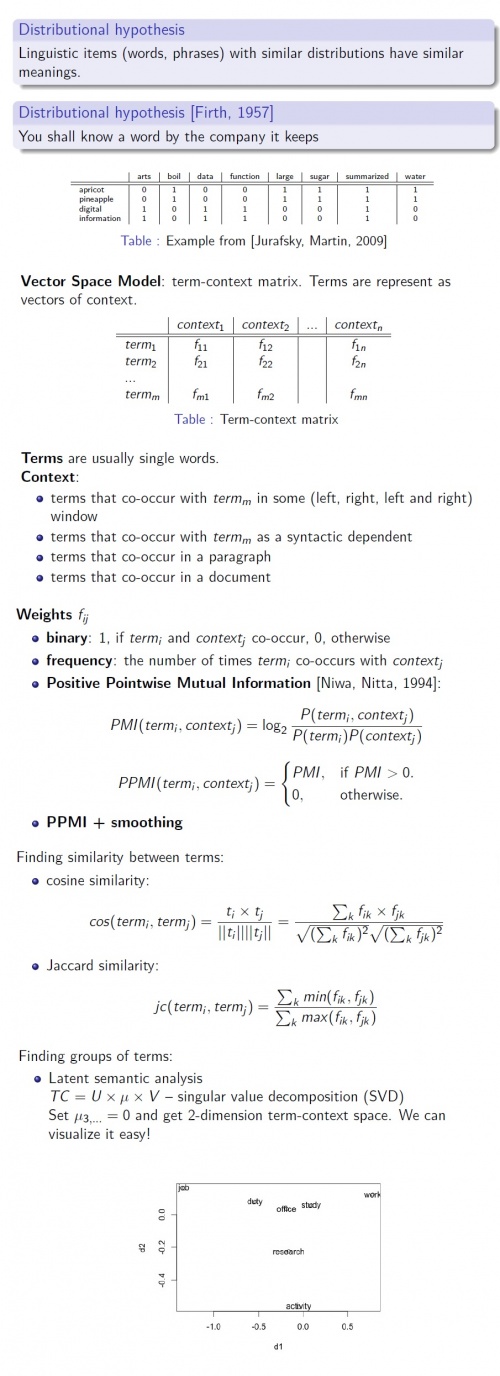Lecture 6. Synonyms and near-synonyms detection — различия между версиями
Polidson (обсуждение | вклад) (→Distributional semantics) |
Polidson (обсуждение | вклад) (→Context-based approach (1) [Lin, 1998]) |
||
| Строка 69: | Строка 69: | ||
=== Context-based approach (1) [Lin, 1998] === | === Context-based approach (1) [Lin, 1998] === | ||
| + | |||
| + | ==== Dependency triple [Lin, 1998] ==== | ||
| + | |||
| + | A dependency triple (w, r, w') consists of two words and the grammatical relationship between them in the input sentence. | ||
| + | |||
| + | I have a brown dog: (have subj I), (I subj-of have), (dog obj-of have), (dog adj-mod brown), (brown adj-mod-of dog), (dog det a), (a det-of dog) | ||
| + | |||
| + | ||w, r, w'|| — frequency of (w, r, w') | ||
| + | |||
| + | ||w, r, * || — total occurrences of w-r relationships | ||
| + | |||
| + | || *, *, *|| — total number of dependency triples | ||
| + | |||
| + | |||
| + | Mutual information between w, w': | ||
| + | |||
| + | [[Файл:L6p2.jpg|300px|слева]] | ||
| + | |||
| + | |||
| + | |||
| + | |||
| + | [[Файл:L6p3.jpg|300px|слева]] | ||
| + | |||
| + | <br> <br> <br> <br> <br> <br> | ||
| + | |||
| + | Results: '''brief(noun)''' — affidavit 0.13, petition 0.05, memo-randum 0.05, motion 0.05, lawsuit 0.05, depo-sition 0.05, slight 0.05, prospectus 0.04, docu-ment 0.04 paper 0.04 | ||
| + | * some sort of dependency parsing is required | ||
| + | * no difference between synonyms and antonyms (win / loose the game) | ||
=== Web or corpus search approach === | === Web or corpus search approach === | ||
Версия 03:31, 3 сентября 2015
Examples
- Synonyms: Netherlands and Holland, buy and purchase
- Near synonyms: pants, trousers and slacks, mistake and error
Approaches to synonyms and near-synonyms detection
- Thesaurus-based approach
- Distributional semantics
- Context-based approach
- word2vec
- Web search-based approach
Synonyms in WordNet
Given a word, look for synonyms in every synset.
WordNet NLTK interface
In[1]: for i,j in enumerate(wn.synsets('error')):
In[2]: print "Meaning",i, "NLTK ID:", j.name()
In[3]: print "Definition:",j.definition()
In[4]: print "Synonyms:", ", ".join(j.lemma names())
Wordnet Web interface: [1]
Distributional semantics
Exercise 6.1
Calculate PPMI for Table 1.
Exercise 6.2
Input: def.txt or your own text
Output 1: term-context matrix
Output 2: term-term similarity matrix (use cosine similarity)
Output 3: 2D visualization by means of LSA
Hint: use cfd = nltk.ConditionalFreqDist((term, context) for ...) for computing conditional frequency dictionary
Hint: use R for SVD and visualization
word2vec [Mikolov, Chen, Corrado, Dean, 2013]
Very complex machine learning (deep learning) applied to term-context matrices.
There are two regimes:
- CBOW predicts the current word based on the context
- Skip-gram predicts surrounding words given the current word
word2vec project page: [2] demo: [3]
Example: vec(Madrid) - vec(Spain) + vec(France) = vec(Paris)
Context-based approach (1) [Lin, 1998]
Dependency triple [Lin, 1998]
A dependency triple (w, r, w') consists of two words and the grammatical relationship between them in the input sentence.
I have a brown dog: (have subj I), (I subj-of have), (dog obj-of have), (dog adj-mod brown), (brown adj-mod-of dog), (dog det a), (a det-of dog)
||w, r, w'|| — frequency of (w, r, w')
||w, r, * || — total occurrences of w-r relationships
|| *, *, *|| — total number of dependency triples
Mutual information between w, w':
Results: brief(noun) — affidavit 0.13, petition 0.05, memo-randum 0.05, motion 0.05, lawsuit 0.05, depo-sition 0.05, slight 0.05, prospectus 0.04, docu-ment 0.04 paper 0.04
- some sort of dependency parsing is required
- no difference between synonyms and antonyms (win / loose the game)


